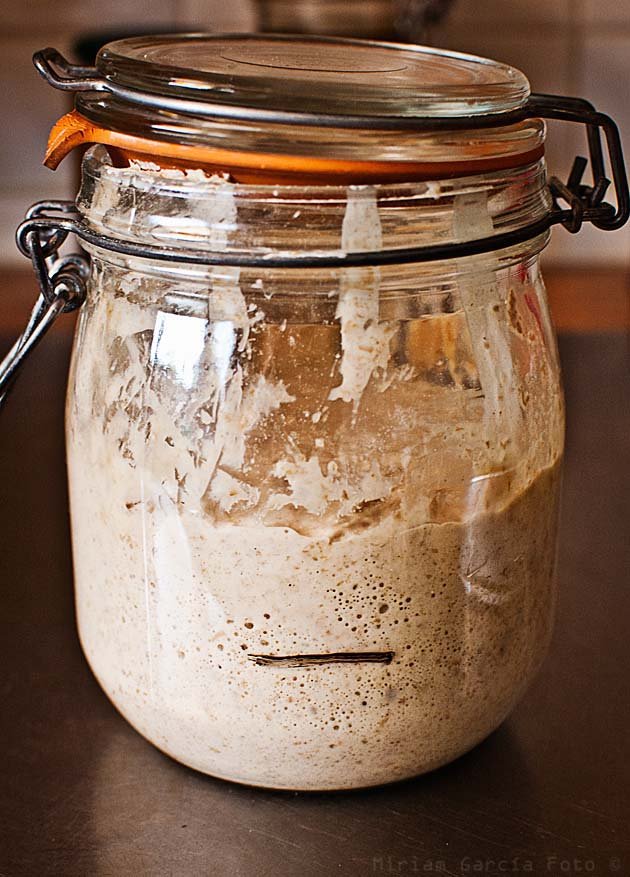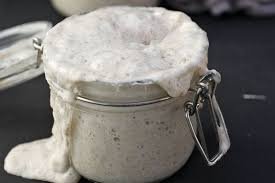Si algo bueno tengo que salvar de los inicios de la Pandemia y la cuarentena estricta es que me sirvió para detenerme a investigar sobre algunas cuestiones pendientes, una de ellas es la masa madre.
Casualmente o no, al menos aquí en Argentina, se gesto una ola paralela al virus de personas interesadas en este tema y gracias a eso abundante información para poder iniciar este proceso.
English
If I have something good to save from the beginnings of the Pandemic and the strict quarantine, it is that it helped me to stop to investigate some pending issues, one of them is sourdough.
Coincidentally or not, at least here in Argentina, there is a wave parallel to the virus of people interested in this issue and thanks to that, abundant information to be able to start this process.
¿Qué es?
Básicamente la masa madre es un fermento que se elabora mezclando harina y agua en iguales proporciones (o aproximadamente).
Los microorganismos responsables de este proceso de fermentación llevan el nombre de Saccharomyses y se encuentran en la superficies de frutos y granos, como ser la harina.
English
What is it?
Basically the sourdough is a ferment that is made by mixing flour and water in equal proportions (or approximately).
The microorganisms responsible for this fermentation process bear the name Saccharomyses and are found on the surfaces of fruits and grains, such as flour.
¿Para qué se usa?
Una porción de este fermento se utiliza para hacer pan desde épocas antiquísimas, cuando la levadura comercial que conocemos no existía.
English
For what do you use it?
A portion of this ferment has been used to make bread since ancient times, when the commercial yeast that we know did not exist.
Ahora bien, ¿cómo se hace?
Existen muchas formas de hacerla. Hay quienes pesan el agua y la harina para ser super exactos, hay quienes agregan frutas, hay también quienes primero fermentan una fruta en agua y utilizan esa agua fermentada como iniciador de su masa madre.
Yo elegí la forma que encontré más sencilla y al alcance de todo el mundo en casa.
Eso si, para que la masa madre este lista necesitas repetir un procedimiento muy sencillo por al menos 4 días.
English
Now, how is it done?
There are many ways to do it. There are those who weigh the water and the flour to be super exact, there are those who add fruits, there are also those who first ferment a fruit in water and use that fermented water as a starter for their sourdough.
I chose the way that I found the simplest and within everyone's reach at home.
Of course, for the sourdough to be ready you need to repeat a very simple procedure for at least 4 days.
¿Qué necesitas?
Harina. Dicen que es mejor integral, hasta recomiendan algunas marcas, pero yo desde el principio utilicé la harina panificable, o 000, que m’as a mano encuentre en el supermercado o el almacén.
- Agua.
- Un frasco de vidrio.
- Paciencia y amor.
English
What do you need?
Flour. They say it is better whole wheat, they even recommend some brands, but from the beginning I used the bread flour, or 000, that I find more readily available in the supermarket or grocery store.
- Water.
- A glass jar.
- Patience and love
¿Y ahora qué?
Introduce en el frasco dos cucharadas colmadas de harina y unas cuatro cucharadas de agua templada, ni fría ni caliente. Mezcla hasta integrar.
La textura debe ser como de papilla. Si te quedo muy liquida, puedes rectificar con un poco de harina y si te quedo muy solida agregarle un poco de agua.
Deja reposar 24 horas en algún rincón cálido de tu casa.
Con suerte, luego de un día veras algunas burbujas tímidas asomarse.
Y aunque no suceda aun, repite el procedimiento por cuatro dias y veras como van apareciendo.
El segundo día puedes colocar una bandita elástica en el frasco o con un marcador indicar el limite en donde esta tu preparación.
Empezara a suceder que al cabo de dos o tres horas (dependiendo de la temperatura ambiente) de agregarle agua y harina (llamaremos a esto “alimentar”) la masa madre duplica su tamaño y luego vuelve a bajar.
Al cuarto día la mezcla se tornara mas aireada luego del reposo, tendrá una textura como de mouse.
Felicidades!!! Tu masa madre esta lista para hacer pan!!!
English
And now that?
Put two heaping tablespoons of flour and about four tablespoons of warm water, neither hot nor cold, into the jar. Mix until integrated.
The texture should be like mush. If it is very liquid, you can rectify with a little flour and if it is very solid add a little water.
Let it rest for 24 hours in a warm corner of your house.
Hopefully after a day you will see some shy bubbles popping out.
And even if it does not happen yet, repeat the procedure for four days and you will see how they appear.
The second day you can place an elastic band on the bottle or with a marker indicate the limit where your preparation is.
It begins to happen that after two or three hours (depending on the ambient temperature) of adding water and flour (we will call this "feeding") the sourdough doubles in size and then goes down again.
On the fourth day the mixture will become more airy after resting, it will have a texture like a mouse.
Congratulations!!! Your sourdough is ready to make bread !!!
Luego seguirán los “refrescos” Esto es:
Cada 24 hs (unas horas mas o unas horas menos, no pasa nada!) deberas desechar la mitad de tu masa madre y volver a alimentar. Esto, a menos que quieras que tu masa madre siga creciendo hasta tomar toda tu cocina, jajaja!.
Si no haces pan muy seguido y prefieres ahorrarte el tiempo y la harina, puedes refrescar tu masa madre, esperar a que duplique y si no vas a usarla, la guardas en el refrigerador. Ahi puedes alimentarla una vez por semana, o cada diez días.
En otro post contar’e mas sobre como conservarla.
Si quieres saber como preparar pan con tu masa madre quédate atento! Voy a preparar otro post con el paso a paso.
English
Then the "refreshments" will follow. This is:
Every 24 hours (a few hours more or a few hours less, nothing happens!) You should discard half of your sourdough and feed again. This, unless you want your sourdough to continue growing until it takes all of your cooking, hahaha !.
If you do not make bread very often and you prefer to save time and flour, you can refresh your sourdough, wait for it to double and if you are not going to use it, store it in the refrigerator. There you can feed it once a week, or every ten days.
In another post I will tell more about how to keep it.
If you want to know how to prepare bread with your sourdough, stay tuned! I will prepare another post with the step by step.




Congratulations @ela.muds! You have completed the following achievement on the Hive blockchain and have been rewarded with new badge(s) :
Your next target is to reach 1000 upvotes.
You can view your badges on your board and compare yourself to others in the Ranking
If you no longer want to receive notifications, reply to this comment with the word
STOPSupport the HiveBuzz project. Vote for our proposal!
¡Felicidades! Esta publicación obtuvo upvote y fue compartido por @la-colmena, un proyecto de Curación Manual para la comunidad hispana de Hive que cuenta con el respaldo de @curie.
Si te gusta el trabajo que hacemos, te invitamos a darle tu voto a este comentario y a votar como testigo por Curie.
Si quieres saber más sobre nuestro proyecto, acompáñanos en Discord: La Colmena.
Muchas gracias @la-colmena por el apoyo!!!
@ela.muds he intentado antes hacer la masa madre y fué una frustración. Con tus indicaciones intentaré reivindicarme. Una pregunta: primer día 2 de harina 4 de agua. Despues, el "repetir procedimiento" seria "alimentar" esta papilla con la nueva harina y agua todo junto? O hacer otra "papilla" primero y luego agregarla? Gracias!
Sisi! Alimentar la misma papilla para que se vaya multiplicando! Una vez que esta activa se empiezan a hacer los “refrescos” que consisten en utilizar o desechar la mitad y la mitad que queda, alimentarla. Éxitos!!! Después cuéntame cómo te fue! 🙌🏼
Estas en Uruguay bo! Chido! Llegue a ti por @la-colmena. Lindo blog, Seguiré sus andanzas por acá, saludos, y q no pare la exploración!